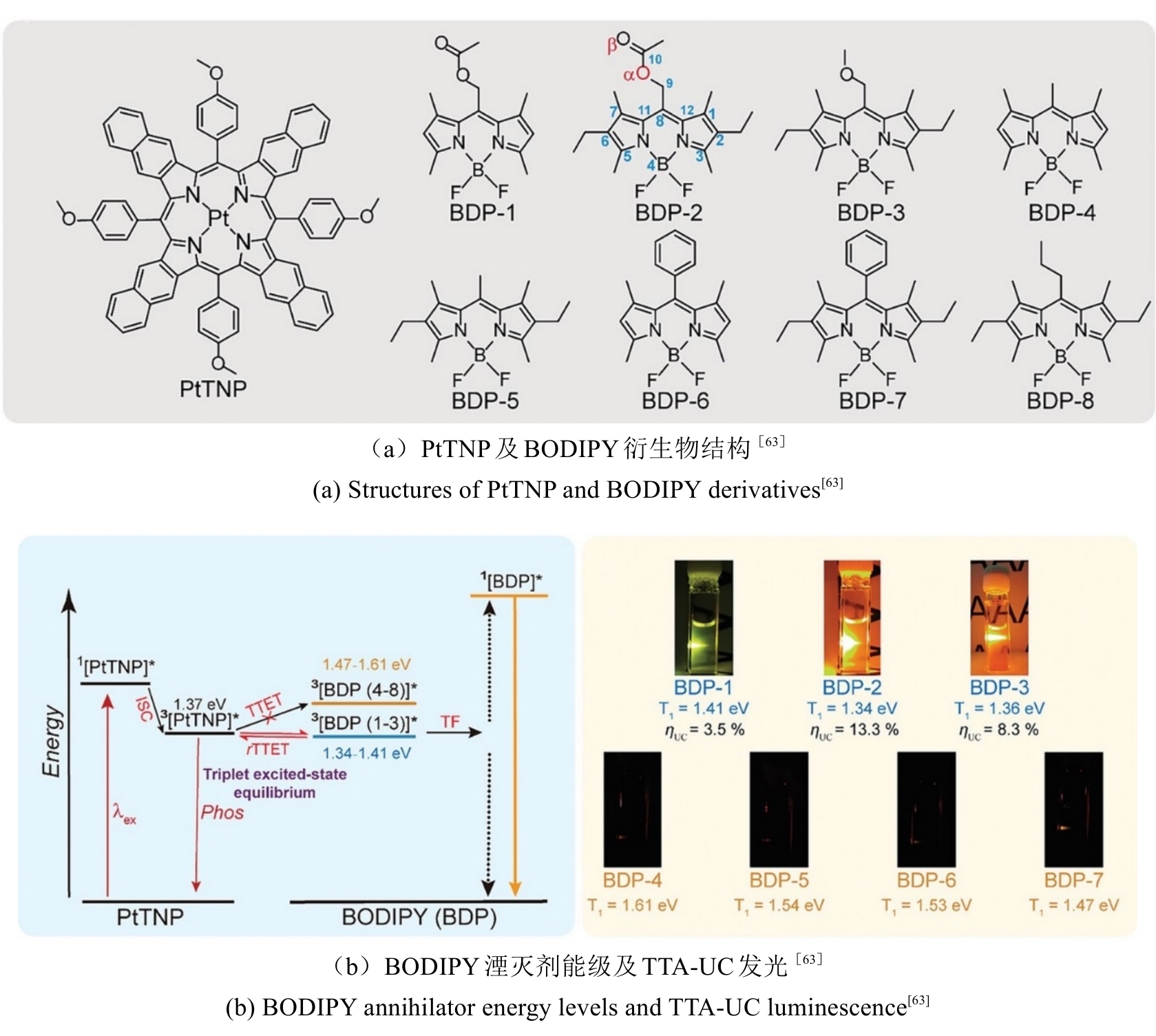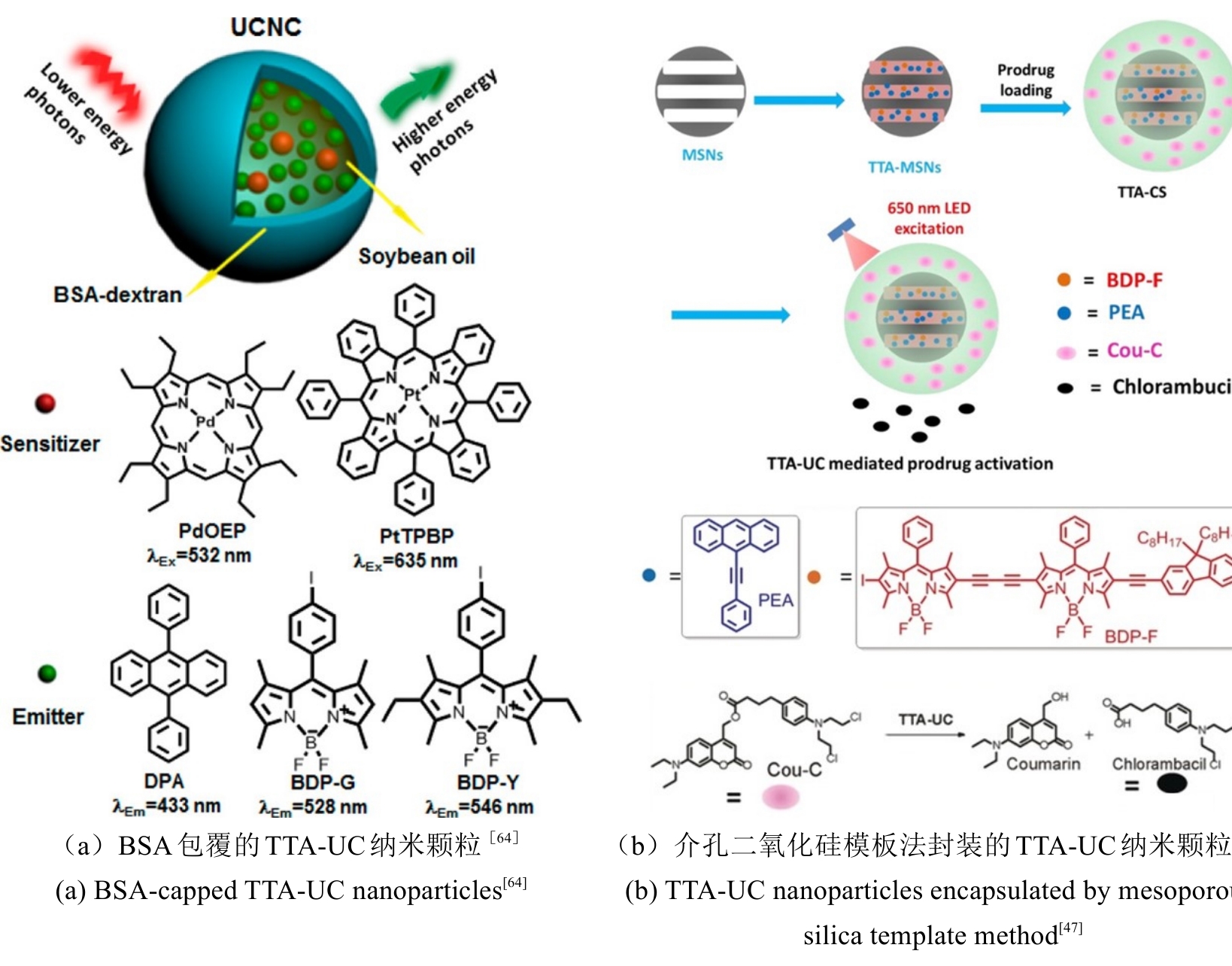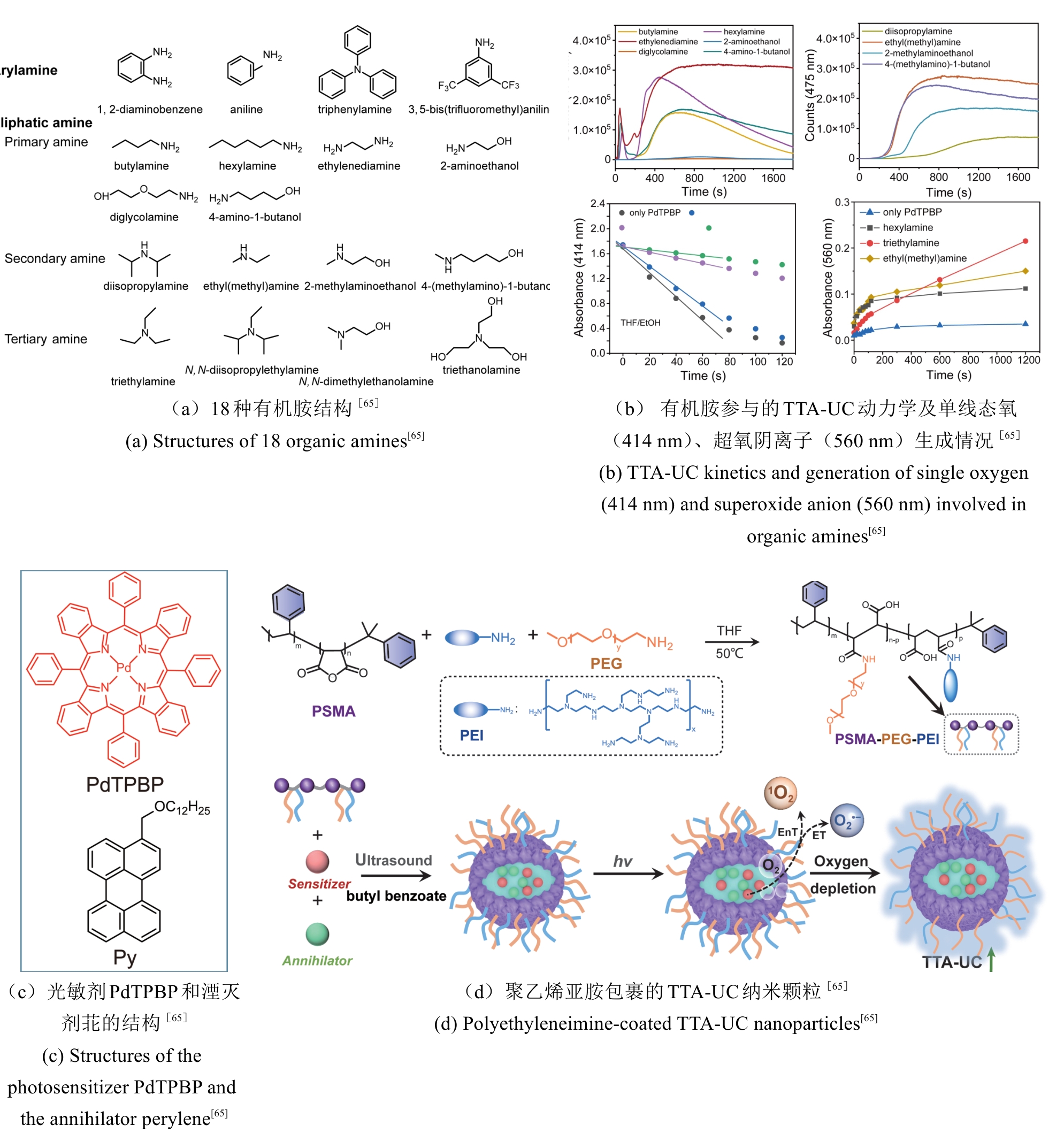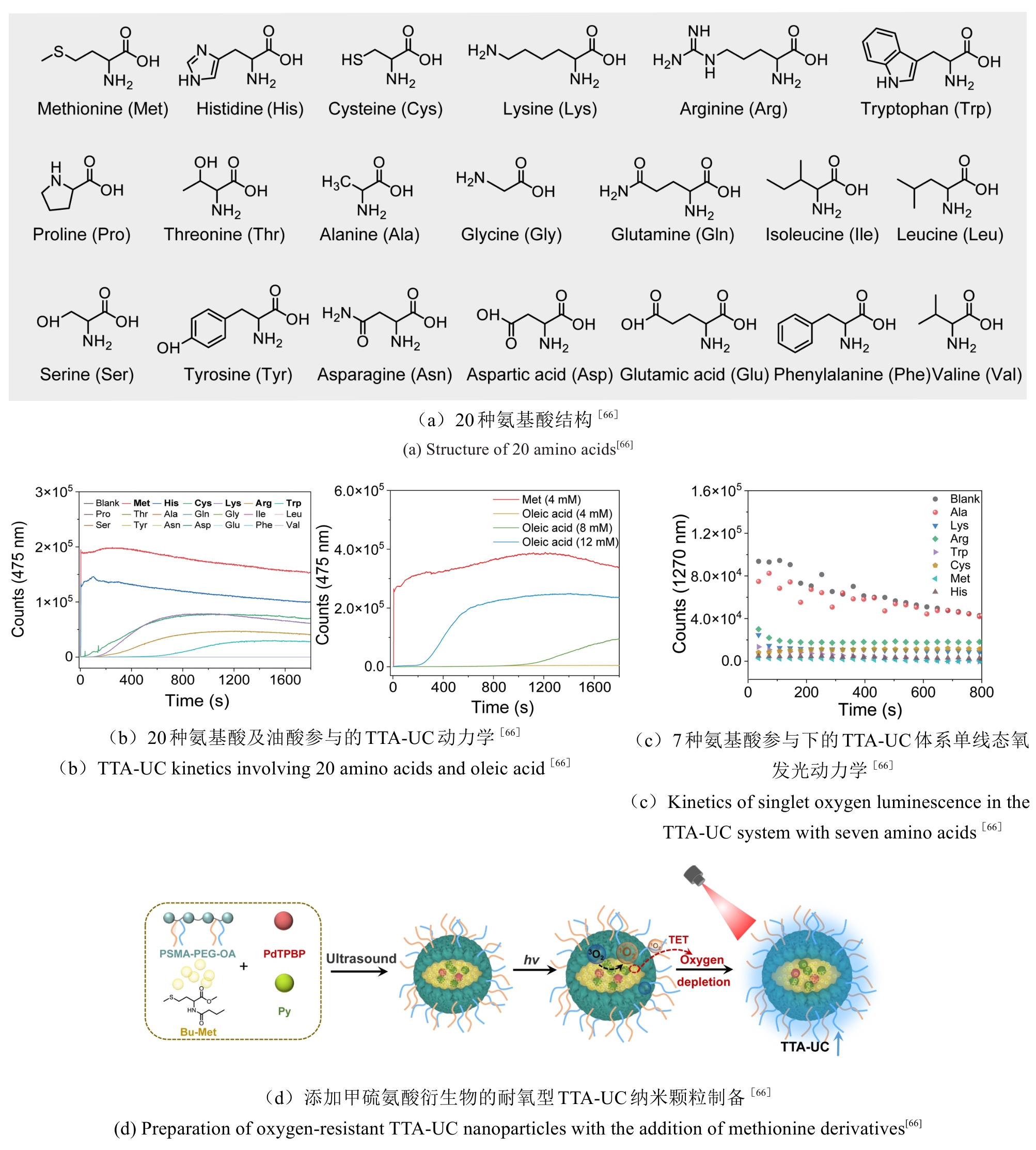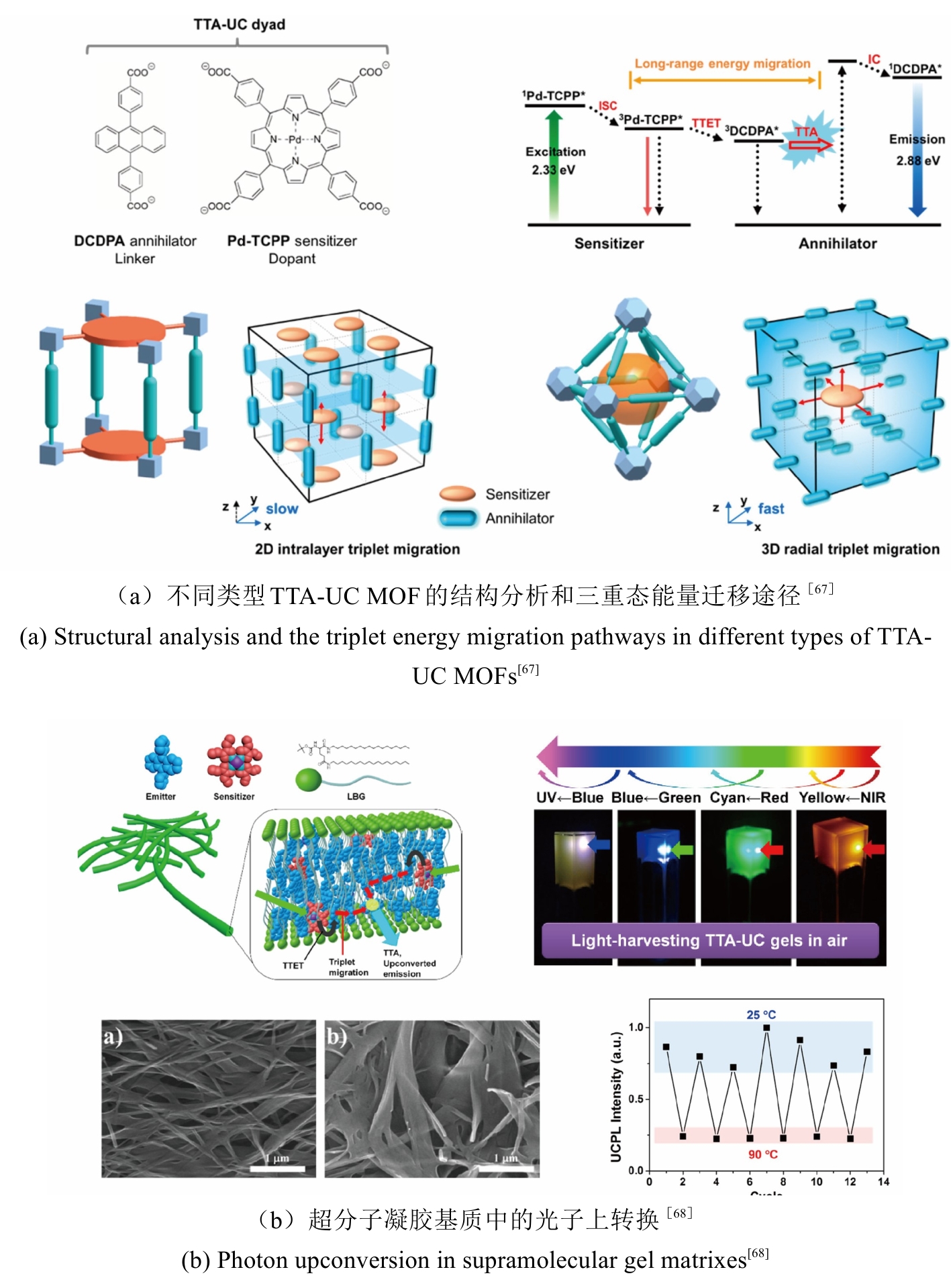• 特约评述 •
耐氧、高效的有机三重态-三重态湮灭上转换发光研究进展
齐放, 裴晨旭, 李嘉尧, 彭怡, 林雯月, 冯红娟, 黄灵
- 天津市生物传感与分子识别重点实验室,分析科学研究中心,有机新物质前沿科学中心,海河可持续化学转化实验室,南开大学化学学院,中国 天津 300071
-
收稿日期:2025-04-16修回日期:2025-05-24出版日期:2025-05-26 -
通讯作者:冯红娟,黄灵 -
作者简介:齐放 (2000—),女,南开大学化学学院硕士研究生。研究方向为三重态-三重态湮灭上转换,光氧化还原催化。 E-mail:qf13642193805@163.com冯红娟 (1996—),女,南开大学化学学院博士研究生。研究方向为三重态-三重态湮灭上转换、蛋白自组装体、上转换生物传感方法开发。 E-mail:fhj2856307797@163.com黄灵 (1989—),男,南开大学化学学院研究员,博士生导师。研究方向为光敏剂,三重态-三重态湮灭上转换,光遗传学。长期致力于有机分子的三重态光物理性质研究,发展了一系列近红外吸收强、三重态寿命长的有机光敏剂,探讨了光敏剂分子结构与激发态性质的构效关系,构建了激发光功率低、吸收和发射波长可调、生物兼容性好、可代谢的近红外三重态湮灭上转换发光体系,大幅提升了生物成像与传感的信背比、分辨率、灵敏度,促进了基于上转换发光的生物成像与传感技术在生物医学中的广泛应用。 E-mail:huangl1@nankai.edu.cn -
基金资助:国家自然科学基金(22377063);南开大学科研启动基金,海河可持续化学转化实验室资金支持(24HHWCSS00020);国家自然科学基金(224B2405)
Progress in oxygen-resistant and efficient organic triplet-triplet annihilation upconversion luminescence
QI Fang, PEI Chenxu, LI Jiayao, PENG Yi, LIN Wenyue, FENG Hongjuan, HUANG Ling
- Tianjin Key Laboratory of Biosensing and Molecular Recognition,Research Center for Analytical Sciences,Frontiers Science Center for New Organic Matter,Haihe Laboratory of Sustainable Chemical Transformations,College of Chemistry,Nankai University,Tianjin 300071,China
-
Received:2025-04-16Revised:2025-05-24Online:2025-05-26 -
Contact:FENG Hongjuan, HUANG Ling
摘要:
基于三重态-三重态湮灭机制的上转换发光(TTA-UC)材料因其独特的光物理特性,在生物医学领域展现出广阔的应用前景。这类材料通过双光子吸收过程实现低能量激发光向高能量发射光的转换,使其在深层组织成像、精准光动力治疗及神经调控等前沿领域具有重要应用价值。然而,氧分子对三重激发态的非辐射猝灭效应严重制约了TTA-UC材料在生物医学中的实际应用。针对这一技术瓶颈,近十年来国内外多个研究团队相继提出了多种抑制氧分子猝灭效应的创新策略。本文系统梳理了当前构建耐氧高效TTA-UC材料的主要技术路径,主要包括提高TTA-UC分子体系的光稳定性的方法、利用还原性油滴清除氧气的策略以及通过微观结构调控分子间三重态能量转移速率的路径,重点阐释了这些方法的工作机理,并系统评估各类方法的优势与局限性。另外,介绍发展TTA-UC纳米颗粒面临的主要挑战,并展望在不久的将来TTA-UC将会与合成生物学交叉融合,发展出生物合成的上转换蛋白,推动上转换发光成为基础的生命科学研究工具,并在多个领域得到实际应用。
中图分类号:
引用本文
齐放, 裴晨旭, 李嘉尧, 彭怡, 林雯月, 冯红娟, 黄灵. 耐氧、高效的有机三重态-三重态湮灭上转换发光研究进展[J]. 合成生物学, DOI: 10.12211/2096-8280.2025-034.
QI Fang, PEI Chenxu, LI Jiayao, PENG Yi, LIN Wenyue, FENG Hongjuan, HUANG Ling. Progress in oxygen-resistant and efficient organic triplet-triplet annihilation upconversion luminescence[J]. Synthetic Biology Journal, DOI: 10.12211/2096-8280.2025-034.
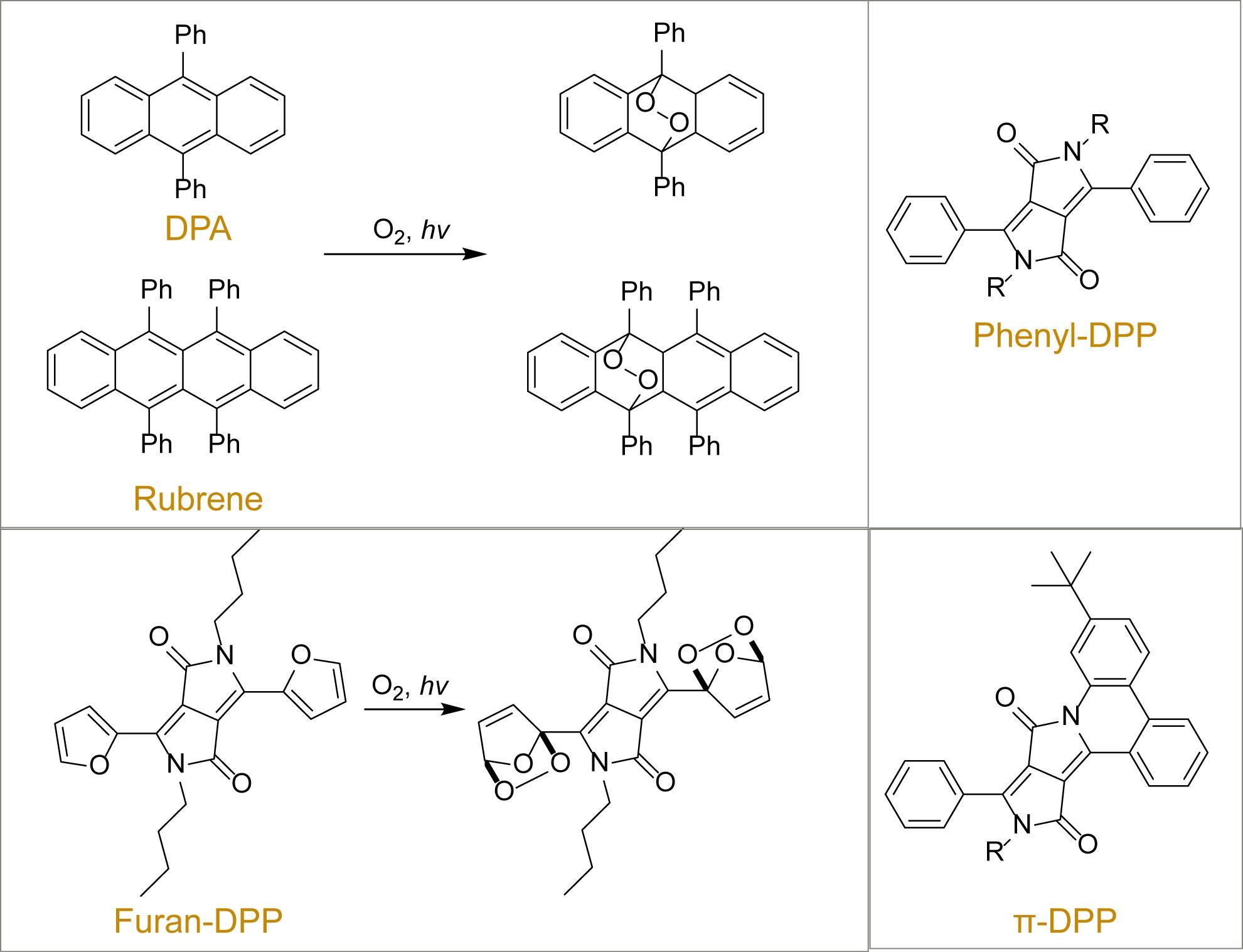
图1 常用的湮灭剂结构及光氧化路径举例[58](9,10-二苯基蒽及红荧烯光氧化路径,呋喃基DPP光氧化路径,苯基DPP及π扩展DPP结构)
Fig. 1 Examples of commonly used annihilator structures and photo-oxidation[58](9,10-diphenylanthracene and red fluorescent alkene photo-oxidation paths, furanyl DPP photo-oxidation paths, phenyl DPP and π-extended DPP structures)
| 1 | RICHARDS B S, HUDRY D, BUSKO D, et al. Photon Upconversion for Photovoltaics and Photocatalysis: A Critical Review[J]. Chemical Reviews, 2021, 121(15): 9165-9195. |
| 2 | DENG Y, JIANG L, HUANG L, et al. Energy Flow in Hybrid Organic/Inorganic Systems for Triplet-Triplet Annihilation Upconversion[J]. ACS Energy Letters, 2022, 7(2): 847-861. |
| 3 | CHENG X, ZHOU J, YUE J, et al. Recent Development in Sensitizers for Lanthanide-Doped Upconversion Luminescence[J]. Chemical Reviews, 2022, 122(21): 15998-16050. |
| 4 | LIU Q, ZHANG Y, PENG C S, et al. Single upconversion nanoparticle imaging at sub-10 W cm-2 irradiance[J]. Nature Photonics, 2018, 12(9): 548-553. |
| 5 | ZHANG Y, WEN R, HU J, et al. Enhancement of single upconversion nanoparticle imaging by topologically segregated core-shell structure with inward energy migration[J]. Nature Communications, 2022, 13(1): 5927. |
| 6 | CHEN S, WEITEMIER A Z, ZENG X, et al. Near-infrared deep brain stimulation via upconversion nanoparticle–mediated optogenetics[J]. Science, 2018, 359(6376): 679-684. |
| 7 | WANG F, WEN S, HE H, et al. Microscopic inspection and tracking of single upconversion nanoparticles in living cells[J]. Light: Science & Applications, 2018, 7(4): 18007-18007. |
| 8 | LIU X, YAN C H, CAPOBIANCO J A. Photon upconversion nanomaterials[J]. Chemical Society Reviews, 2015, 44(6): 1299-1301. |
| 9 | WANG X, VALIEV R R, OHULCHANSKYY T Y, et al. Dye-sensitized lanthanide-doped upconversion nanoparticles[J]. Chemical Society Reviews, 2017, 46(14): 4150-4167. |
| 10 | GULZAR A, XU J, YANG P, et al. Upconversion processes: versatile biological applications and biosafety[J]. Nanoscale, 2017, 9(34): 12248-12282. |
| 11 | GNACH A, LIPINSKI T, BEDNARKIEWICZ A, et al. Upconverting nanoparticles: assessing the toxicity[J]. Chemical Society Reviews, 2015, 44(6): 1561-1584. |
| 12 | ZHU X, SU Q, FENG W, et al. Anti-Stokes shift luminescent materials for bio-applications[J]. Chemical Society Reviews, 2017, 46(4): 1025-1039. |
| 13 | CHEN X, ZHANG X, ZHAO Y. Metal-organic framework-based hybrids with photon upconversion[J]. Chemical Society Reviews, 2025, 54(1): 152-177. |
| 14 | BHARMORIA P, BILDIRIR H, MOTH-POULSEN K. Triplet-triplet annihilation based near infrared to visible molecular photon upconversion[J]. Chemical Society Reviews, 2020, 49(18): 6529-6554. |
| 15 | XIAO X, TIAN W, IMRAN M, et al. Controlling the triplet states and their application in external stimuli-responsive triplet-triplet-annihilation photon upconversion: from the perspective of excited state photochemistry[J]. Chemical Society Reviews, 2021, 50(17): 9686-9714. |
| 16 | ZHAO J, XU K, YANG W, et al. The triplet excited state of Bodipy: formation, modulation and application[J]. Chemical Society Reviews, 2015, 44(24): 8904-8939. |
| 17 | ZHAO J, WU W, SUN J, et al. Triplet photosensitizers: from molecular design to applications[J]. Chemical Society Reviews, 2013, 42(12): 5323-5351. |
| 18 | C-F LEUNG, LAU T-C. Organic photosensitizers for catalytic solar fuel generation[J]. Energy & Fuels, 2021, 35(23): 18888-18899. |
| 19 | YE K, IMRAN M, CHEN X, et al. Triplet Photosensitizers and Their Applications in Triplet-Triplet Annihilation Upconversion[J]. ACS Applied Optical Materials, 2024, 2(9): 1803-1824. |
| 20 | SCHLOEMER T, NARAYANAN P, ZHOU Q, et al. Nanoengineering triplet–triplet annihilation upconversion: from materials to real-world applications[J]. ACS Nano, 2023, 17(4): 3259-3288. |
| 21 | WANG Z, ZHAO J, BARBON A, et al. Radical-enhanced intersystem crossing in new Bodipy derivatives and application for efficient triplet–triplet annihilation upconversion[J]. Journal of the American Chemical Society, 2017, 139(23): 7831-7842. |
| 22 | HUANG L, WU W, LI Y, et al. Highly effective near-infrared activating triplet-triplet annihilation upconversion for photoredox catalysis[J]. Journal of the American Chemical Society, 2020, 142(43): 18460-18470. |
| 23 | FAN C, WEI L, NIU T, et al. Efficient triplet-triplet annihilation upconversion with an anti-Stokes shift of 1.08 eV achieved by chemically tuning sensitizers[J]. Journal of the American Chemical Society, 2019, 141(38): 15070-15077. |
| 24 | JIN P, XU X, YAN Y, et al. Luminescent Fe (III) Complex Sensitizes Aerobic Photon Upconversion and Initiates Photocatalytic Radical Polymerization[J]. Journal of the American Chemical Society, 2024, 146(51): 35390-35401. |
| 25 | HUANG Z, TANG M L. Designing transmitter ligands that mediate energy transfer between semiconductor nanocrystals and molecules[J]. Journal of the American Chemical Society, 2017, 139(28): 9412-9418. |
| 26 | SUN W, RONCHI A, ZHAO T, et al. Highly efficient photon upconversion based on triplet-triplet annihilation from bichromophoric annihilators[J]. Journal of Materials Chemistry C, 2021, 9(40): 14201-14208. |
| 27 | OLESUND A, JOHNSSON J, EDHBORG F, et al. Approaching the spin-statistical limit in visible-to-ultraviolet photon upconversion[J]. Journal of the American Chemical Society, 2022, 144(8): 3706-3716. |
| 28 | CABANERO D C, ROVIS T. Low-energy photoredox catalysis[J]. Nat Rev Chem, 2025, 9(1): 28-45. |
| 29 | RAVETZ B D, PUN A B, CHURCHILL E M, et al. Photoredox catalysis using infrared light via triplet fusion upconversion[J]. Nature, 2019, 565(7739): 343-346. |
| 30 | HUANG L, HAN G. Triplet-triplet annihilation photon upconversion-mediated photochemical reactions[J]. Nature Reviews Chemistry, 2024, 8(4): 238-255. |
| 31 | SCHULZE T F, CZOLK J, CHENG Y-Y, et al. Efficiency enhancement of organic and thin-film silicon solar cells with photochemical upconversion[J]. The Journal of Physical Chemistry C, 2012, 116(43): 22794-22801. |
| 32 | NATTESTAD A, CHENG Y Y, MACQUEEN R W, et al. Dye-sensitized solar cell with integrated triplet-triplet annihilation upconversion system[J]. The Journal of Physical Chemistry Letters, 2013, 4(12): 2073-2078. |
| 33 | BEERY D, SCHMIDT T W, HANSON K. Harnessing sunlight via molecular photon upconversion[J]. ACS applied materials & interfaces, 2021, 13(28): 32601-32605. |
| 34 | CARROD A J, GRAY V, BöRJESSON K. Recent advances in triplet-triplet annihilation upconversion and singlet fission, towards solar energy applications[J]. Energy & Environmental Science, 2022, 15(12): 4982-5016. |
| 35 | SCHULZE T F, SCHMIDT T W. Photochemical upconversion: present status and prospects for its application to solar energy conversion[J]. Energy & Environmental Science, 2015, 8(1): 103-125. |
| 36 | NAIMOVIČIUS L, BHARMORIA P, MOTH-POULSEN K. Triplet–triplet annihilation mediated photon upconversion solar energy systems[J]. Materials Chemistry Frontiers, 2023, 7(12): 2297-2315. |
| 37 | DOU Q, JIANG L, KAI D, et al. Bioimaging and biodetection assisted with TTA-UC materials[J]. Drug Discovery Today, 2017, 22(9): 1400-1411. |
| 38 | LIN W, LI J, FENG H, et al. Recent Advances in Triplet-Triplet Annihilation Upconversion for Bioimaging and Biosensing[J]. Journal of Analysis and Testing, 2023, 7(4): 327-344. |
| 39 | HUANG L, KAKADIARIS E, VANECKOVA T, et al. Designing next generation of photon upconversion: Recent advances in organic triplet-triplet annihilation upconversion nanoparticles[J]. Biomaterials, 2019, 201: 77-86. |
| 40 | ZHANG B, RICHARDS K D, JONES B E, et al. Ultra-Small Air-Stable Triplet-Triplet Annihilation Upconversion Nanoparticles for Anti-Stokes Time-Resolved Imaging[J]. Angewandte Chemie International Edition, 2023, 62(47): e202308602. |
| 41 | MEIR R, HIRSCHHORN T, KIM S, et al. Photon upconversion hydrogels for 3D optogenetics[J]. Advanced Functional Materials, 2021, 31(31): 2010907. |
| 42 | UJI M, KONDO J, HARA-MIYAUCHI C, et al. In Vivo Optogenetics Based on Heavy Metal-Free Photon Upconversion Nanoparticles[J]. Advanced Materials, 2024, 36(46): 2405509. |
| 43 | SASAKI Y, OSHIKAWA M, BHARMORIA P, et al. Near‐infrared optogenetic genome engineering based on photon‐upconversion hydrogels[J]. Angewandte Chemie International Edition, 2019, 58(49): 17827-17833. |
| 44 | HUANG L, ZENG L, CHEN Y, et al. Long wavelength single photon like driven photolysis via triplet triplet annihilation[J]. Nature Communications, 2021, 12(1): 122. |
| 45 | LONG K, LV W, WANG Z, et al. Near-infrared light-triggered prodrug photolysis by one-step energy transfer[J]. Nature Communications, 2023, 14(1): 8112. |
| 46 | ZENG L, JIANG L H, LI J Y, et al. Metal-Free Far-Red Light-Driven Photolysis via Triplet Fusion to Enhance Checkpoint Blockade Immunotherapy[J]. Angewandte Chemie International Edition, 2023, 62(11): e202218341. |
| 47 | HUANG L, ZHAO Y, ZHANG H, et al. Expanding anti‐Stokes shifting in triplet-triplet annihilation upconversion for in vivo anticancer prodrug activation[J]. Angewandte Chemie International Edition, 2017, 129(46): 14592-14596. |
| 48 | BORISOV S M, LARNDORFER C, KLIMANT I. Triplet-Triplet Annihilation-Based Anti-Stokes Oxygen Sensing Materials with a Very Broad Dynamic Range[J]. Advanced Functional Materials, 2012, 22(20): 4360-4368. |
| 49 | XU M, ZOU X, SU Q, et al. Ratiometric nanothermometer in vivo based on triplet sensitized upconversion[J]. Nature Communications, 2018, 9(1): 2698. |
| 50 | HUANG L, LE T, HUANG K, et al. Enzymatic enhancing of triplet-triplet annihilation upconversion by breaking oxygen quenching for background-free biological sensing[J]. Nature Communications, 2021, 12(1): 1898. |
| 51 | WANG X, DING F, JIA T, et al. Molecular near-infrared triplet-triplet annihilation upconversion with eigen oxygen immunity[J]. Nature Communications, 2024, 15(1): 2157. |
| 52 | FENG H J, ZENG L, LI J Y, et al. Natural Protein Photon Upconversion Supramolecular Assemblies for Background-Free Biosensing[J]. Journal of the American Chemical Society, 2024, 146(31): 21791-21805. |
| 53 | ZHANG M Y, FENG H J, LI J Y, et al. High‐Performance 721 nm-Excitable Photon Upconversion Porous Aromatic Frameworks for Broad‐Range Oxygen Sensing and Efficient Heterogeneous Photoredox Catalysis[J]. Advanced Materials, 2025: 2502150. |
| 54 | FILATOV M A, BALUSCHEV S, LANDFESTER K. Protection of densely populated excited triplet state ensembles against deactivation by molecular oxygen[J]. Chemical Society Reviews, 2016, 45(17): 4668-4689. |
| 55 | HUANG Z, C-H TUNG, WU L-Z. Quantum Dot-Sensitized Triplet–Triplet Annihilation Photon Upconversion for Solar Energy Conversion and beyond[J]. Accounts of Materials Research, 2024, 5(2): 136-145. |
| 56 | FLORS C, GRIESBECK A G, VASSILIKOGIANNAKIS G. Singlet Oxygen: Chemistry, Applications and Challenges Ahead[J]. ChemPhotoChem, 2018, 2(7): 510-511. |
| 57 | FAN X, FU Q, LIU G, et al. Applying molecular oxygen for organic pollutant degradation: Strategies, mechanisms, and perspectives[J]. Environmental Science and Ecotechnology, 2024, 22: 100469. |
| 58 | QI F, FENG H-J, PENG Y, et al. New Type Annihilator of π-Expanded Diketopyrrolopyrrole for Robust Photostable NIR-Excitable Triplet–Triplet Annihilation Upconversion[J]. ACS applied materials & interfaces, 2024, 16(6): 7512-7521. |
| 59 | LIU Q, XU M, YANG T, et al. Highly Photostable Near-IR-Excitation Upconversion Nanocapsules Based on Triplet-Triplet Annihilation for in Vivo Bioimaging Application[J]. ACS Applied Materials & Interfaces, 2018, 10(12): 9883-9888. |
| 60 | FALLON K J, CHURCHILL E M, SANDERS S N, et al. Molecular Engineering of Chromophores to Enable Triplet-Triplet Annihilation Upconversion[J]. Journal of the American Chemical Society, 2020, 142(47): 19917-19925. |
| 61 | PUN A B, CAMPOS L M, CONGREVE D N. Tunable Emission from Triplet Fusion Upconversion in Diketopyrrolopyrroles[J]. Journal of the American Chemical Society, 2019, 141(9): 3777-3781. |
| 62 | SINGH-RACHFORD T N, HAEFELE A, ZIESSEL R, et al. Boron Dipyrromethene Chromophores: Next Generation Triplet Acceptors/Annihilators for Low Power Upconversion Schemes[J]. Journal of the American Chemical Society, 2008, 130(48): 16164-16165. |
| 63 | JIANG L-H, ZENG L, ZHANG M-Y, et al. Highly Effective Near-Infrared Light-Activatable Triplet Fusion Upconversion with BODIPY Annihilators: Triplet Modulation via Non-Conjugated n-π Spatial Electron Coupling[J]. Advanced Optical Materials, 2024, 12(1): 2301879. |
| 64 | LIU Q, YIN B, YANG T, et al. A General Strategy for Biocompatible, High-Effective Upconversion Nanocapsules Based on Triplet-Triplet Annihilation[J]. Journal of the American Chemical Society, 2013, 135(13): 5029-5037. |
| 65 | FENG H-J, QI F, LI J-Y, et al. Dual Roles of the Photooxidation of Organic Amines for Enhanced Triplet-Triplet Annihilation Upconversion in Nanoparticles[J]. Nano Letters, 2024, 24(28): 8770-8777. |
| 66 | QI F, FENG H-J, LI J-Y, et al. Amino Acids-Enabled Fast-Restore of Triplet-Triplet Annihilation Upconversion Luminescence for Background-Free Sensing of Herbicides[J]. Small Methods, n/a(n/a): 2401945. |
| 67 | PARK J, XU M, LI F, et al. 3D Long-Range Triplet Migration in a Water-Stable Metal-Organic Framework for Upconversion-Based Ultralow-Power in Vivo Imaging[J]. Journal of the American Chemical Society, 2018, 140(16): 5493-5499. |
| 68 | DUAN P, YANAI N, NAGATOMI H, et al. Photon Upconversion in Supramolecular Gel Matrixes: Spontaneous Accumulation of Light-Harvesting Donor-Acceptor Arrays in Nanofibers and Acquired Air Stability[J]. Journal of the American Chemical Society, 2015, 137(5): 1887-1894. |
| 69 | WEI L, FAN C, RAO M, et al. Triplet-triplet annihilation upconversion in LAPONITE®/PVP nanocomposites: absolute quantum yields of up to 23.8% in the solid state and application to anti-counterfeiting[J]. Materials Horizons, 2022, 9(12): 3048-3056. |
| 70 | WEI L, YANG C, WU W. Optimizing TTA-UC performance by chemically tuning sensitizers and orderly organizing sensitizers and annihilators[J]. Chemical Communications, 2025. |
| 71 | LIANG W, NIE C, DU J, et al. Near-infrared photon upconversion and solar synthesis using lead-free nanocrystals[J]. Nature Photonics, 2023, 17(4): 346-353. |
| [1] | 盛周煌, 陈智仙, 张彦. 酵母甘露糖蛋白的研究进展[J]. 合成生物学, 2025, 6(2): 408-421. |
| [2] | 鲁锦畅, 武耀康, 吕雪芹, 刘龙, 陈坚, 刘延峰. 神经酰胺类鞘脂的绿色生物制造[J]. 合成生物学, 2025, 6(2): 422-444. |
| [3] | 韦灵珍, 王佳, 孙新晓, 袁其朋, 申晓林. 黄酮类化合物生物合成及其在化妆品中应用的研究[J]. 合成生物学, 2025, 6(2): 373-390. |
| [4] | 肖森, 胡立涛, 石智诚, 王发银, 余思婷, 堵国成, 陈坚, 康振. 可控分子量透明质酸的生物合成研究进展[J]. 合成生物学, 2025, 6(2): 445-460. |
| [5] | 汤传根, 王璟, 张烁, 张昊宁, 康振. 功能肽合成和挖掘策略研究进展[J]. 合成生物学, 2025, 6(2): 461-478. |
| [6] | 黄姝涵, 马赫, 罗云孜. 生物合成红景天苷的研究进展[J]. 合成生物学, 2025, 6(2): 391-407. |
| [7] | 仲泉周, 单依怡, 裴清云, 金艳芸, 王艺涵, 孟璐远, 王歆韵, 张雨鑫, 刘坤媛, 王慧中, 冯尚国. 生物合成法生产α-熊果苷的研究进展[J]. 合成生物学, 2025, 6(1): 118-135. |
| [8] | 竺方欢, 岑雪聪, 陈振. 微生物合成二元醇研究进展[J]. 合成生物学, 2024, 5(6): 1367-1385. |
| [9] | 刘益宁, 蒲伟, 杨金星, 王钰. ω-氨基酸与内酰胺的生物合成研究进展[J]. 合成生物学, 2024, 5(6): 1350-1366. |
| [10] | 李庚, 申晓林, 孙新晓, 王佳, 袁其朋. 过氧化物酶的重组表达和应用研究进展[J]. 合成生物学, 2024, 5(6): 1498-1517. |
| [11] | 郑皓天, 李朝风, 刘良叙, 王嘉伟, 李恒润, 倪俊. 负碳人工光合群落的设计、优化与应用[J]. 合成生物学, 2024, 5(5): 1189-1210. |
| [12] | 程晓雷, 刘天罡, 陶慧. 萜类化合物的非常规生物合成研究进展[J]. 合成生物学, 2024, 5(5): 1050-1071. |
| [13] | 刘子健, 穆柏杨, 段志强, 王璇, 陆晓杰. 与核酸兼容的化学反应开发进展[J]. 合成生物学, 2024, 5(5): 1102-1124. |
| [14] | 张守祺, 王涛, 孔尧, 邹家胜, 刘元宁, 徐正仁. 天然产物的化学-酶法合成:方法与策略的演进[J]. 合成生物学, 2024, 5(5): 913-940. |
| [15] | 谢向前, 郭雯, 王欢, 李进. 含氨基乙烯半胱氨酸核糖体肽的生物合成与化学合成[J]. 合成生物学, 2024, 5(5): 981-996. |
| 阅读次数 | ||||||
|
全文 |
|
|||||
|
摘要 |
|
|||||
